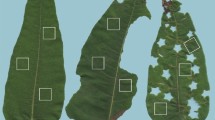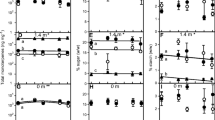Abstract
Induction of plant chemical defenses in response to insect feeding may be localized to the site of damage or expressed systemically, mediated by signal transduction throughout the plant. Such systemic induction processes have been widely investigated in plants with single stems, but rarely in clonal plants comprised of multiple ramets with vascular connections. For a clonal tree species such as trembling aspen (Populus tremuloides Michx), integration of induced defense within clones could be adaptive, as clones are spatially extensive and susceptible to outbreak herbivores. We used pairs of aspen saplings with shared roots, replicated from three genotypes, to determine whether defense-induction signals are communicated within clones. One ramet in each pair was subjected to a damage treatment (feeding by Lymantria dispar, followed by mechanical damage), and subsequent changes in leaf defensive chemistry were measured in both ramets. Responses to damage varied by defense type: condensed tannins (CTs) increased in damaged ramets but not in connected undamaged ramets, whereas salicinoid phenolic glycosides (SPGs) were not induced in any ramets. Genotypes varied in their levels of CTs, but not in their levels of SPGs, and responded similarly to damage treatment. These results suggest that, even with both vascular and volatile information available, young aspen ramets do not induce defenses based on signals or metabolites from other ramets. Thus, unlike other clonal plant species, aspen do not appear to coordinate defense induction within clones. Lack of coordinated early induction in aspen may be related to the function of CTs in tolerance, rather than resistance.



Similar content being viewed by others
References
Arnold T, Appel H, Patel V, Stocum E, Kavalier A, Schultz J (2004) Carbohydrate translocation determines the phenolic content of Populus foliage: a test of the sink-source model of plant defense. New Phytol 164:157–164. https://doi.org/10.1111/j.1469-8137.2004.01157.x
Babst BA, Ferrieri RA, Thorpe MR, Orians CM (2008) Lymantria dispar herbivory induces rapid changes in carbon transport and partitioning in Populus nigra. Entomol Exp Appl 128(1):117–125
Baret M, DesRochers A (2011) Root connections can trigger physiological responses to defoliation in nondefoliated aspen suckers. Botany 89:753–761. https://doi.org/10.1139/b11-062
Bretfeld M, Franklin SB, Hubbard RM (2017) Initial evidence for simultaneous, bi-directional sap flow in roots of interconnected aspen ramets (Populus tremuloides). Folia Geobot 52:345–352. https://doi.org/10.1007/s12224-017-9285-0
Chen JS, Lei NF, Liu Q (2011) Defense signaling among interconnected ramets of a rhizomatous clonal plant, induced by jasmonic-acid application. Acta Oecol 37:355–360. https://doi.org/10.1016/j.actao.2011.04.002
Cole CT, Stevens MT, Anderson JE, Lindroth RL (2016) Heterozygosity, gender, and the growth-defense trade-off in quaking aspen. Oecologia 181:381–390. https://doi.org/10.1007/s00442-016-3577-6
Donaldson JR, Lindroth RL (2007) Genetics, environment, and their interaction determines efficacy of chemical defense in trembling aspen. Ecology 88:729–739. https://doi.org/10.1890/06-0064
Donaldson JR, Lindroth RL (2008) Effects of variable phytochemistry and budbreak phenology on defoliation of aspen during a forest tent caterpillar outbreak. Agric For Entomol 10:399–410. https://doi.org/10.1111/j.1461-9563.2008.00392.x
Frost CJ, Appel HM, Carlson JE, de Moraes CM, Mescher MC, Schultz JC (2007) Within-plant signalling via volatiles overcomes vascular constraints on systemic signalling and primes responses against herbivores. Ecol Lett 10:490–498. https://doi.org/10.1111/j.1461-0248.2007.01043.x
Gómez S, Stuefer JF (2006) Members only: induced systemic resistance to herbivory in a clonal plant network. Oecologia 147:461–468. https://doi.org/10.1007/s00442-005-0293-z
Gómez S, Onoda Y, Ossipov V, Stuefer JF (2008) Systemic induced resistance: a risk-spreading strategy in clonal plant networks? New Phytol 179:1142–1153. https://doi.org/10.1111/j.1469-8137.2008.02542.x
Gómez S, van Dijk W, Stuefer JF (2010) Timing of induced resistance in a clonal plant network. Plant Biol 12:512–517. https://doi.org/10.1111/j.1438-8677.2009.00234.x
Hagerman AE, Butler LG (1989) Choosing appropriate methods and standards for assaying tannin. J Chem Ecol 15:1795–1810. https://doi.org/10.1007/BF01012267
Heil M, Ton J (2008) Long-distance signalling in plant defence. Trends Plant Sci 13:264–272. https://doi.org/10.1016/j.tplants.2008.03.005
Jelínková H, Tremblay F, Desrochers A (2012) Herbivore-simulated induction of defenses in clonal networks of trembling aspen (Populus tremuloides). Tree Physiol 32:1348–1356. https://doi.org/10.1093/treephys/tps094
Karban R, Agrawal AA, Thaler JS, Adler LS (1999) Induced plant responses and information content about risk of herbivory. Trends Ecol Evol 14:443–447. https://doi.org/10.1016/S0169-5347(99)01678-X
Li T, Blande JD (2017) Volatile-mediated within-plant signaling in hybrid aspen: required for systemic responses. J Chem Ecol 43:327–338. https://doi.org/10.1007/s10886-017-0826-z
Lindroth RL, St. Clair SB (2013) Adaptations of quaking aspen (Populus tremuloides Michx.) for defense against herbivores. For Ecol Manag 299:14–21
Liu F, Liu J, Dong M (2016) Ecological consequences of clonal integration in plants. Front Plant Sci 7:1–11. https://doi.org/10.3389/fpls.2016.00770
Madritch MD, Lindroth RL (2015) Condensed tannins increase nitrogen recovery by trees following insect defoliation. New Phytol 208:410–420. https://doi.org/10.1111/nph.13444
Mattson WJ, Palmer SR (1988) Changes in levels of foliar minerals and phenolics in trembling aspen, Populus tremuloides, in response to artificial defoliation. In: Mattson WJ, Levieux J, Bernard-Dagan C (eds) Mechanisms of Woody Plant defenses against insects. Springer-Verlag, New York, pp 157–170
Orians C (2005) Herbivores, vascular pathways, and systemic induction: facts and artifacts. J Chem Ecol 31:2231–2242. https://doi.org/10.1007/s10886-005-7099-7
Osier TL, Lindroth RL (2001) Effects of genotype, nutrient availability, and defoliation on aspen phytochemistry and insect performance. J Chem Ecol 27:1289–1313. https://doi.org/10.1023/A:1010352307301
Osier TL, Lindroth RL (2006) Genotype and environment determine allocation to and costs of resistance in quaking aspen. Oecologia 148:293–303. https://doi.org/10.1007/s00442-006-0373-8
Porter LJ, Hrstich LN, Chan BG (1985) The conversion of procyanidins and prodelphinidins to cyanidin and delphinidin. Phytochemistry 25:223–230. https://doi.org/10.1016/S0031-9422(00)94533-3
Rubert-Nason KF, Couture JJ, Major IT, Constabel CP, Lindroth RL (2015) Influence of genotype, environment, and gypsy moth herbivory on local and systemic chemical defenses in trembling aspen (Populus tremuloides). J Chem Ecol 41:651–661. https://doi.org/10.1007/s10886-015-0600-z
Rubert-Nason KF, Couture JJ, Gryzmala EA, Townsend PA, Lindroth RL (2017) Vernal freeze damage and genetic variation alter tree growth, chemistry, and insect interactions. Plant Cell Environ 40:1–11. https://doi.org/10.1111/pce.13042
Stevens MT, Lindroth RL (2005) Induced resistance in the indeterminate growth of aspen (Populus tremuloides). Oecologia 145:298–306. https://doi.org/10.1007/s00442-005-0128-y
Stuefer JF, Gómez S, Van Mölken T (2004) Clonal integration beyond resource sharing: implications for defence signalling and disease transmission in clonal plant networks. Evol Ecol 18:647–667. https://doi.org/10.1007/s10682-004-5148-2
Tew RK, DeByle NV, Schultz JD (1969) Intraclonal root connections among quaking aspen trees. Ecology 50:920–921
Tsai C-J, Harding SA, Tschaplinski TJ, Lindroth RL, Yuan Y (2006) Genome-wide analysis of the structural genes regulating defense phenylpropanoid metabolism in Populus. New Phytol 172:47–62. https://doi.org/10.1111/j.1469-8137.2006.01798.x
Van Groenendael JM, Klimes L, Klimesova J, Hendriks RJJ (1996) Comparative ecology of clonal plants. Philos Trans R Soc B Biol Sci 351:1331–1339. https://doi.org/10.1098/rstb.1996.0116
Acknowledgements
We thank K. Rubert-Nason, S. Jaeger, and D. Rutkowski for assistance in executing the study. We also thank two anonymous reviewers for their valuable feedback on earlier versions of this manuscript. This research was supported by United States Department of Agriculture McIntire-Stennis project WIS01842 and National Science Foundation grant DEB-1456592. O. Cope was supported in part by an NSF Graduate Research Fellowship.
Author information
Authors and Affiliations
Corresponding author
Rights and permissions
About this article
Cite this article
Cope, O.L., Lindroth, R.L. Clonal Saplings of Trembling Aspen Do Not Coordinate Defense Induction. J Chem Ecol 44, 1045–1050 (2018). https://doi.org/10.1007/s10886-018-1006-5
Received:
Revised:
Accepted:
Published:
Issue Date:
DOI: https://doi.org/10.1007/s10886-018-1006-5




